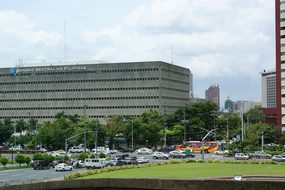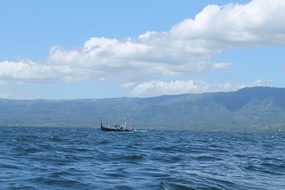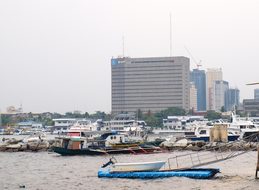Cost of living and prices in Manila, prices of food, rent, shopping, etc. 🇵🇭
Updated Jul 2023
Discover Manila, the vibrant capital city of the Philippines! Manila is located in South-Eastern Asia and boasts a population of over 1.7 million people at an elevation of 13 meters above sea level. If you're considering moving to Manila or just visiting, you may be wondering about the cost of living.
The cost of living in Manila can be quite affordable compared to other major cities in Asia. Rent, transportation, and food are generally inexpensive, making it an attractive destination for budget-conscious travelers and expats. However, other expenses such as healthcare and education may be higher than in other parts of the Philippines. It's important to do your research and create a budget that takes into account your specific needs and lifestyle when planning your move to Manila.
Manila is a bustling city with a rich history and culture. Whether you're interested in exploring historic sites, enjoying the nightlife, or simply trying local cuisine, Manila has something for everyone. Consider visiting the famous Intramuros walled city, the beautiful Rizal Park, or indulging in traditional Filipino cuisine at one of the many restaurants around the city. With its affordable cost of living and endless opportunities for adventure, Manila is definitely worth considering as your next destination.
Cost of Living Estimate in Manila
You can calculate cost of living in Manila by changing quantity using input near each good or service. Resulting total will appear in a floating box in the bottom of your screen.
Restaurants prices
Manila is a thriving city and there is no shortage of great restaurants and dining options to satisfy any craving. Traditional Filipino cuisine is the star of the show, with everything from lechon, adobo, and sinigang served up in local eateries. For those who crave international flavors, Manila also offers a diverse array of options, ranging from Japanese, Korean, Italian, and even American dining spots. If you're looking for a unique food experience, be sure to try balut, a fertilized duck egg that is boiled and eaten with salt and vinegar. It may sound strange, but it's a local delicacy that's worth trying at least once in your life.
Aside from traditional restaurants, street food is a huge part of Manila's food culture. You'll find food stalls selling everything from barbecue skewers and isaw (grilled chicken intestine) to taho (a sweet tofu dessert) and sorbetes (Filipino ice cream). Food fairs and night markets are also increasingly popular options for those looking for a more vibrant food scene. To get the most out of your Manila food experience, we recommend trying a little bit of everything - from high-end dining to street food, there's something for everyone in this bustling city.
Markets prices
Manila is a bustling metropolis that operates under a dynamic market economy. As with any other cosmopolitan city, the prices of commodities in Manila are subject to various factors such as supply and demand, inflation, and market competition. Despite this, Manila has become known for its affordable prices for many goods and services. From food to transportation, the cost of living in Manila is relatively cheaper compared to other major cities in Asia.
The Philippine peso is the official currency of the Philippines and is widely used in transactions within the city. As a tourist destination, Manila offers a vast array of shopping options that cater to different budgets. High-end malls with global luxury brands are available, while night markets present affordable and unique finds. Prices may vary depending on the location, product quality, and season. However, Manila's market prices remain competitive while being friendly to travelers looking for an affordable yet memorable vacation.
Transportation prices
If you're traveling to Manila, Philippines, you'll encounter a variety of transportation options that cater to different budgets, preferences, and travel requirements. One of the most popular transportation options is the ubiquitous Jeepney, a colorful and unique vehicle that can take you to almost anywhere in the city. Jeepneys are a manifestation of Filipino ingenuity, as they were converted from US military jeeps left over from World War II. They offer a cheap and exciting way to experience Manila's bustling streets and lively culture. Another common mode of transportation in Manila is the tricycle, a motorbike carriage that can carry up to three passengers. Tricycles are especially useful for short-distance trips and navigating narrow alleys and busy markets.
If you want to travel in comfort and style, Manila has plenty of taxis and ride-hailing services like Grab and Uber. Taxis are plentiful but may have varying conditions and rates, so it's advisable to choose reputable taxi companies to avoid scams and overcharging. Meanwhile, Grab and Uber offer competitive rates, reliable service, and real-time tracking of your ride. These options are ideal for tourists who want to explore Manila's tourist spots or attend business meetings without the common hassles of commuting. Whether you choose Jeepneys, tricycles, taxis, or ride-hailing apps, getting around Manila is an adventure by itself.
Utilities Per Month prices
Traveling to Manila, Philippines can be an exciting and exhilarating experience. However, one aspect of living in the city that can catch travelers off guard is the cost of utilities. Like many major cities, Manila has high utility costs, particularly when it comes to electricity and water. Visitors to the city should be prepared to budget accordingly and keep an eye on their usage to prevent unexpected fees and charges.
While the high cost of utilities in Manila may seem daunting, there are ways to save money and keep your bills manageable. One option is to opt for a more energy-efficient lifestyle, such as turning off lights and appliances when not in use or taking shorter showers. Other options include choosing accommodations that have energy-saving features, such as LED lighting or low-flow toilets and showerheads. By being mindful of your usage and making conscious decisions about your energy consumption, you can enjoy your trip to Manila without worrying about hefty utility bills.
Sports And Leisure prices
Sports and leisure activities are abundant in Manila, making it an excellent city for active travelers. One of the most popular activities is basketball, which is widely played in the city's parks and sports centers. Many of the local universities have their court, and they even have their league. The city is also famous for its numerous golf courses, both public and private, that offer world-class greens and beautiful scenic surroundings. Some of the courses are even designed by famous golfers, making it a must-play for any visitor who enjoys the sport.
When it comes to leisure activities, Manila also has a lot to offer. The city has a diverse nightlife scene, with several bars, clubs, and entertainment spots to choose from. You can enjoy live music, dancing, and drinks well into the night. Foodies can indulge in a variety of local and international cuisine, from street food to haute cuisine. The city also has several shopping centers, where you can find both international and local brands. Overall, Manila is a city with something for everyone, whether you are looking for sports or leisure.
Salaries And Financing prices
Salaries and financing can play a big role in determining the quality of your trip to Manila, Philippines. The good news is that the cost of living in Manila can be relatively low compared to other major cities in the region. However, this can also depend on the type of experience you are looking for. If you plan on staying in high-end hotels and dining at fancy restaurants, you may need to budget more for your trip.
When it comes to financing, it's always a good idea to have a mix of payment options on hand. Credit cards are widely accepted throughout Manila, but it's always a good idea to carry some cash for smaller transactions or in case of emergencies. ATMs are also plentiful, but be aware that fees can vary depending on the machine and your bank. It's always a good idea to check with your bank beforehand to see if they have any partnerships with local banks that can help you avoid fees.
Childcare prices
Childcare prices in Manila, Philippines can vary greatly depending on the type of facility you are looking for. For parents searching for a school, prices tend to be higher than those for Kindergartens. This is due in part to the longer hours schools are open, as well as the added benefits of a more structured curriculum and specialized teachers. Although schools are typically more expensive, they offer a more comprehensive education and provide students with a strong foundation for future academic success.
For those seeking more affordable childcare options, Kindergartens in Manila can be a great choice. While they may not offer the same level of academic rigor as schools, Kindergartens still provide children with a safe and nurturing environment to learn and play. Additionally, many Kindergartens offer a variety of activities and programs to further enhance a child's social and intellectual development. Regardless of which childcare option you choose, it is important to do your research to find a facility that aligns with your family's values and budget.
Clothing And Shoes prices
Shopping for clothing and shoes in Manila is an exciting experience because of the diverse options available. From high-end designer brands to affordable streetwear, you will find everything here. Manila is home to various shopping malls such as SM Mall of Asia, Greenbelt, and Glorietta, where you can find international and local clothing brands. You can also explore local markets like Divisoria and Baclaran for bargain deals on clothing and shoes.
Aside from shopping malls and markets, there are also online stores that offer a wide range of clothing and shoes. Numerous e-commerce platforms are now available in the Philippines, making shopping more accessible and convenient. You can browse through different websites like Zalora, Lazada, and Shopee to find trendy clothing and footwear. These online stores offer almost everything you need, from formal wear to casual outfits, from sneakers to heels.
Rent Per Month prices
Short-term rental options in Manila, Philippines are plentiful, and cater to the needs of both business and leisure travelers. The city offers a range of fully furnished apartments, serviced suites, and condominiums, available for periods as brief as a few days to as long as a few months. Prices vary depending on location, size, and amenities offered, but generally, these short-term rental options are a cost-effective alternative to hotels, especially if you're looking for more space, privacy, and the ability to cook your own meals.
For those seeking an affordable stay in Manila, there are also several hostel options available. Hostels are a great option if you're traveling solo or on a budget and don't need a lot of space or extra amenities. Some hostels even offer private rooms, which are great for couples or small groups. Prices for hostels are generally lower than other short-term rental options, but you may have to sacrifice some level of privacy for the lower price point. Regardless of which short-term stay option you choose, you're sure to find something that meets your needs and budget in Manila.
Buy Apartment prices
The real estate market in Manila, Philippines offers a range of buying options to cater to every budget and preference. From luxurious high-rise condominiums to affordable townhouses and single-family homes, there are plenty of choices available for investors and homebuyers alike. Location is a crucial factor that determines the prices of properties in Manila. Prime areas such as Makati and Bonifacio Global City command higher prices, while suburbs like Quezon City and Pasig City offer more affordable options.
The prices of real estate properties in Manila, Philippines continue to rise due to the growing demand driven by population growth and urbanization. However, there are still opportunities to find good deals and investment opportunities in emerging areas and up-and-coming neighborhoods. With the ongoing infrastructure developments and government initiatives to attract foreign investments, the real estate market in Manila is expected to remain strong and attractive to both local and international buyers.









